NR 503 EPIDEMIOLOGY (NR503)
Chamberlain College Of Nursing
Page 3 out of 72 results
Sort by
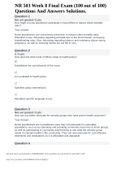
-
NR 503 Week 8 Final Exam, NR 503 Epidemiology Week 5 Final Exam Reviewer, Nr 503 week 4 Midterm Exam 2023, NR-503 Week 8 Final Exam Study Guide (Chapter 2 – 20),NR 503 Week 7 Graded Discussion Presentation Of Epidemiological Problem, NR 503 MID-TERM EXAM
- Package deal • 8 items • 2023
-
- $60.49
- + learn more
NR 503 Week 8 Final Exam, NR 503 Epidemiology Week 5 Final Exam Reviewer, Nr 503 week 4 Midterm Exam 2023, NR-503 Week 8 Final Exam Study Guide (Chapter 2 – 20),NR 503 Week 7 Graded Discussion Presentation Of Epidemiological Problem, NR 503 MID-TERM EXAM (2021) Questions & Answers, NR-503 Final Exam 2021 Graded+ & NR 503 WEEK 5 Final exam review.
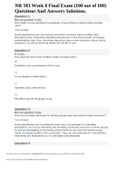
-
NR 503 Week 8 Final Exam (100 out of 100) Questions And Answers Solutions, NR 503 Week 5 Final Exam Reviewer, Nr 503 week 4 Midterm Exam 2023, NR 503 Week 8 Final Exam Study Guide, NR 503 Week 7 Graded Discussion Presentation Of Epidemiological Problem &
- Package deal • 6 items • 2023
-
- $50.49
- + learn more
NR 503 Week 8 Final Exam (100 out of 100) Questions And Answers Solutions, NR 503 Week 5 Final Exam Reviewer, Nr 503 week 4 Midterm Exam 2023, NR 503 Week 8 Final Exam Study Guide, NR 503 Week 7 Graded Discussion Presentation Of Epidemiological Problem & NR 503:Week 8 Final Quiz Population Health Epidemiology And Statistical Principles.
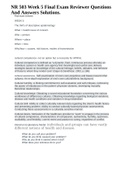
-
NR 503 Week 5 Final Exam Review Questions And Answers Solutions, NR 503 Week 8 Final Exam (100 out of 100) Questions And Answers Solutions, Nr 503 week 4 Midterm Exam 2023 Revised Questions & Correct Answers & NR 503 Week 7 Graded Discussion: Presentation
- Package deal • 4 items • 2023
-
- $35.49
- + learn more
NR 503 Week 5 Final Exam Review Questions And Answers Solutions, NR 503 Week 8 Final Exam (100 out of 100) Questions And Answers Solutions, Nr 503 week 4 Midterm Exam 2023 Revised Questions & Correct Answers & NR 503 Week 7 Graded Discussion: Presentation Of Epidemiological Problem.
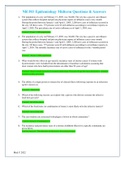
-
NR-503 Population Health, Epidemiology & Statistical Principles -MID-TERM EXAM
- Exam (elaborations) • 5 pages • 2023
-
- $10.99
- + learn more
NR-503 Population Health, Epidemiology & Statistical Principles -MID-TERM EXAMNR-503Population HealthEpidemiologyStatistical PrinciplesMID-TERM EXAMNR 503 Epidemiology midterm questions & answers: 1. The population of a city on February 15, 2005, was 36,600. The city has a passive surveillance system that collects hospital and private physician reports of influenza cases every month. During the period between January 1 and April 1, 2005, 2,200 new cases of influenza occurred in the city....

-
NR 503 Week 5 Final Exam Review Questions And Answers Solutions.
- Exam (elaborations) • 14 pages • 2023
- Available in package deal
-
- $9.99
- + learn more
NR 503 Week 5 Final Exam Review Questions And Answers Solutions. Final exam reviewer: WEEK 5: The 5W's of descriptive epidemiology: What = health issue of concern Who = person Where = place When = time Why/how = causes, risk factors, modes of transmission cultural competence- not an option but a necessity for APRNs. Cultural competence is defined as “a dynamic, fluid, continuous process whereby an individual, system or health care agency find meaningful and useful care delivery st...
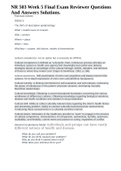
-
NR 503 Epidemiology Week 5 Final Exam Reviewer Questions And Answers Solutions.
- Exam (elaborations) • 14 pages • 2023
- Available in package deal
-
- $10.99
- + learn more
NR 503 Epidemiology Week 5 Final Exam Reviewer Questions And Answers Solutions. Final exam reviewer: WEEK 5: The 5W's of descriptive epidemiology: What = health issue of concern Who = person Where = place When = time Why/how = causes, risk factors, modes of transmission cultural competence- not an option but a necessity for APRNs. Cultural competence is defined as “a dynamic, fluid, continuous process whereby an individual, system or health care agency find meaningful and useful ca...
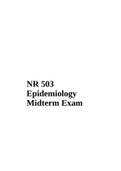
-
NR 503 Epidemiology Midterm Exam QUESTIONS AND ANSWERS
- Exam (elaborations) • 5 pages • 2023
-
- $10.89
- + learn more
NR 503 Epidemiology Midterm Exam. NR 503 Epidemiology Midterm Exam (Latest): Chamberlain College of Nursing Question 1 The population of a city on February 15, 2005, was 36,600. The city has a passive surveillance system that collects hospital and private physician reports of influenza cases every month. During the period between January 1 and April 1, 2005, 2,200 new cases of influenza occurred in the city. Of these cases, 775 persons were ill with influenza according to surveillance r...
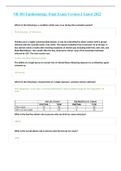
-
Chamberlain College of Nursing NR503 Epidemiology Final Exam ( Version 2) / NR 503 Final Exam: Population Health, Epidemiology & Statistical Principles | Newest-Aug-2022
- Exam (elaborations) • 48 pages • 2023
-
- $15.99
- + learn more
Chamberlain College of Nursing NR503 Epidemiology Final Exam ( Version 2) / NR 503 Final Exam: Population Health, Epidemiology & Statistical Principles | Newest-Aug-2022
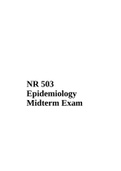
-
NR 503 Epidemiology Midterm Exam.
- Exam (elaborations) • 5 pages • 2023
-
- $10.49
- + learn more
NR 503 Epidemiology Midterm Exam.Question 2 What would be the effect on age-specific incidence rates of uterine cancer if women with hysterectomies were excluded from the denominator of incidence calculations assuming that most women who have had hysterectomies are older than 50 years of age. The rates in all age groups would remain the same. Only rates in women older than 50 years of age would tend to decrease. Rates in women younger than 50 years would increase compared to women older ...

$6.50 for your textbook summary multiplied by 100 fellow students... Do the math: that's a lot of money! Don't be a thief of your own wallet and start uploading yours now. Discover all about earning on Stuvia


